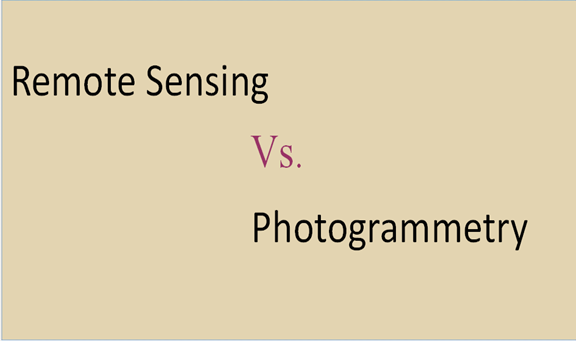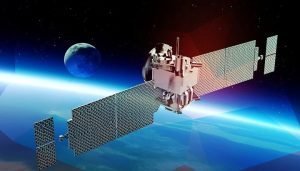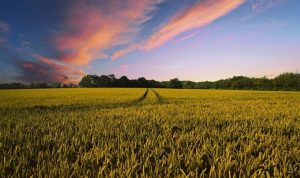1. Definitions
Remote Sensing is a technology that identifies and measures different parameters without direct contact by relying on inspecting different wavelengths of light radiation. Remote Sensing identifies and processes even the tiny differences across an extensive array of wavelengths and spatial orientations. The differences are then used by Professionals in identifying objects and later categorizing them in accordance to their type, material, or location. They can also use them to measure slopes and distances.
On the other hand, Photogrammetry uses imaging rather than collecting light wavelength data. It determines the spatial properties and object dimensions of photographic pictures captured. Photogrammetry relies on aerial triangulation as a technique to measure changes in position. This method involves taking aerial photographs from more than one location and using measurements from both places to pinpoint locations and distances more accurately. The several photographs give various lines of sight or rays from the camera to specific points. The trigonometric intersection of these lines of sight can then produce accurate 3D coordinates for those points.
2. Uses
Remote Sensing has been used in meteorological operations for imagery. It first came into operation because of the high number of color bands in satellite imagery. The technique utilized those color bands to collect 2D information for weather tracking and geographic information system (GIS) mapping, for instance. Today, Many satellites still use remote Sensing to collect a range of information from the Earth in weather and land cover evaluation and to generate maps. It is also useful for generating information and data on terrestrial projects, like surveying or earthworks construction. Remote Sensing incorporates any observance and measurement techniques that don’t rely on direct contact with the object or landform in question.
Photogrammetry is incredibly common in applications such as landforms measuring, topographic map development, and measuring terrains. Multiple industries, including fields as diverse as architecture, construction, engineering, forensics, forestry, geoscience, law, and medicine, rely on the precise and accurate 3D data photogrammetry provides.
3. Types
Photogrammetry has two major types; Metric photogrammetry and interpretive Photogrammetry. Metric Photogrammetry Deals with the precise measurements and computations on photographs regarding the size, shape, and position of photographic features and/or obtaining other information such as relative locations (coordinates) of features, areas, volumes; these photographs are taken using a metric camera and is mostly used in the engineering fields, e.g., surveying, etc. while interpretive photogrammetry Deals with recognition and identification of the photographic features on a photograph such as a shape, size, shadow, pattern, etc. to add value and intelligence to information seen on the photograph(annotation).
Remote Sensing also has two types; Active and passive remote Sensing. Active sensors emit energy to scan objects and areas, whereupon a sensor then detects and measures the radiation that is reflected or backscattered from the target. RADAR and LiDAR are examples of active remote Sensing where the time delay between emission and return is measured, establishing the location, speed, and direction of an object while passive sensors gather radiation that is emitted or reflected by the object or surrounding areas. Reflected sunlight is the most common source of radiation measured by passive sensors. Examples of passive remote sensors include film photography, infrared, charge-coupled devices, and radiometers.
4. Applications
Some of the applications of Remote Sensing include;
- Land Use Mapping; Remote sensing data is beneficial in collecting up-to-date land-use patterns of large areas at any given time monitoring changes that happen from time to time. It is also used to update road maps, asphalt conditions, and wetland tracing. This information is used by regional planners and administrators in formulating policy matters for the all-around development of the region.
- Weather Forecasting; Remote Sensing is largely employed in weather forecasting. It is also used to inform people about hovering cyclones.
- Environmental Study; Remote Sensors study deforestation, fertile land degradation, atmosphere pollution, desertification, eutrophication of large water bodies, and oil spillage from oil tankers.
- Study of Natural hazards; Remote sensing studies damages caused by natural calamities such as earthquakes, volcanoes, landslides, floods, and melting of ice in polar regions. Many times remote Sensing will be beneficial to anticipate the occurrence of natural hazards.
- Resource exploration; Remote sensing data help update existing geological maps, rapid preparation of lineament and tectonic maps, identifying the sites for quarrying the minerals, and helpful in locating fossil fuel deposits.
Some of the Photogrammetry applications include;
- Engineering; In the engineering world, Photogrammetry evaluates construction sites as well as creates perspective images and 3D renderings. With that information, engineers can produce images of project results or previews, as well as analyze their current progress.
- Military Intelligence; Photogrammetry also plays a role in data gathering for military programs. Accurate geo-locational models with low processing times are necessary for understanding a landscape. Aerial imagery and photogrammetric technology can work together to create accurate 3D maps quickly without any human input.
- Film and Entertainment; Photogrammetry can play a big role in set design and world-building for a variety of films and video games. 3D modeling can bring unique objects to fruition in a virtual world, like cityscapes for action sequences and accurate historical elements, such as statues and buildings.
- Forensics; Photogrammetry also plays a part in crime investigation. It can help to document and measure precise data about a crime scene and determine what was physically possible. Many photogrammetric experts can assist in the courtroom.
5. Data Type
One of the main discrepancies between Photogrammetry and remote Sensing lies in the kind of information acquired. Remote Sensing collects data in the form of light and color by inspecting different wavelengths of light radiation, thus generating maps. Instead of gauging wavelengths of radiation, Photogrammetry uses imagery to calculate coordinates in space. Photogrammetry focuses on geometric information of imagery, while Remote Sensing focuses on spectrum information.
6. Dimensions
Remote Sensing was originally developed to take advantage of a large number of color brands in satellite imagery to create 2D data primarily in GIS, while Photogrammetry was created for the generation of accurate 3D survey data. Remote Sensing creates informative 2D maps, while Photogrammetry is perfect for more sophisticated 3D modeling.



